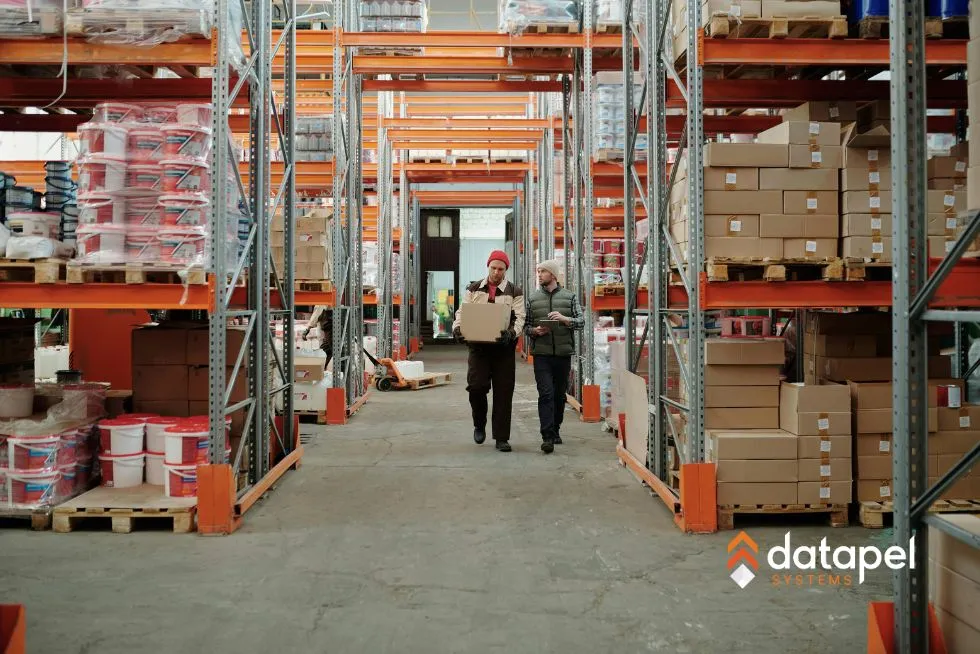5 Warehouse Mistakes You Can Still Fix Before July
Contents
EOFY is nearly here…
And if you’re like most warehouse managers or ops leads, your stocktake has probably revealed a few familiar frustrations: order delays, location mix-ups, out-of-date stock, or just a general sense that the floor is running on memory more than process.
In this blog post, we’ll help you identify and fix common mistakes in your warehouse shipping and inventory management before July.
Here’s the good news: You’ve still got time to fix the most common warehouse issues before they snowball into next quarter’s problems. The advice in this article applies to businesses of all sizes looking to improve efficiency and avoid common mistakes.
These aren’t pie-in-the-sky system overhauls. These are real-world fixes you can start this week — and your future self (and your team) will thank you for it.
Why Warehouse Mistakes Happen (and Why July Matters)
Warehouse mistakes can sneak up on even the most experienced teams, especially as July approaches. When orders ramp up, the cracks in your processes become more obvious: shipping errors, poor inventory management, and inefficient picking and packing can quickly lead to excess inventory, unhappy customers, and lost revenue.
A well-implemented warehouse management system is your best defence, helping you optimise warehouse space, boost inventory accuracy, and keep your team on track.
But even the best systems can’t compensate for outdated processes or a lack of staff training.
The good news? By identifying common warehouse mistakes now, you can take proactive steps to enhance customer satisfaction, reduce costs, and strengthen your supply chain before the busy season hits. Whether you’re running a small business or managing a large facility, fixing these issues now means fewer headaches and happier customers later.
Warehouse Mistakes You Can Still Fix Before July

1. Still Picking by Memory or Paper?
Let’s be honest — if your picking process relies on scribbled lists, shouted part numbers, or “Dave’s got it in his head,” you’re sitting on a time bomb. Relying on paper processes can have the opposite effect of what you want, causing delays and errors instead of improving efficiency.
Manual picking:
- Slows down your team
- Makes training new staff painful
- Guarantees more errors as volume increases
- Inefficiencies lead to higher costs and slower operations
And when someone’s off sick? Everything falls apart.
We’ve seen warehouses where the morning routine still involves walking the floor with a clipboard and highlighting orders while everyone else is waiting for direction. That’s not scalable.
🛠 Quick fix: You don’t need fancy tech to get started. Even a shared spreadsheet or mobile-accessible pick list (Google Sheets, for example) is a step up from paper. Moving away from paper processes helps reduce errors. If you’re already on a WMS, ensure mobile scanning is active. It can slash errors and boost confidence overnight. Remember to train your staff on new digital picking methods to ensure a smooth transition.
2. Reorder Points You Set and Forgot
Remember when you set your min/max levels? No? That’s the problem. Maintaining optimal stock levels is crucial to avoid both stockouts and overstocking, ensuring you meet customer demand without tying up excess capital.
Reorder points only work if they reflect now — not six months ago when demand looked different and your top SKUs hadn’t changed.
If you’ve had to:
- Manually top up stock that “shouldn’t have run out”
- Write off slow movers you kept reordering automatically
- Chase suppliers last-minute because no one saw it coming
…then your reorder logic is outdated.
🛠 Quick fix: Pull the last 90 days of movement for your top 20 SKUs. Cross-check against your reorder triggers. If they’re off by more than 15–20%, adjust. This small calibration can make a big difference in cash flow and availability and you only need to do a few at a time.
Regular audits of inventory and reorder points help maintain accuracy and prevent discrepancies, supporting effective inventory management.
Keeping optimal stock levels not only improves cash flow but also supports a smoother fulfillment process.
3. No Expiry or Batch Alerts Impacting Inventory Accuracy?
For food & beverage, health, or beauty stock — this one’s critical. If you don’t have active expiry or batch alerts, you’re relying on someone to “remember” what’s going out of date. That’s not a process, that’s a gamble.
We’ve seen teams “discover” expired goods weeks after they should have been used or sold. It’s not just wasteful — it’s also damaging to customer trust if you’re sending out anything close to expiry. Without proper expiry or batch alerts, there’s a higher risk of shipping incorrect items to customers, such as expired or wrong batch products.
🛠 Quick fix: Even if your system doesn’t have built-in alerts, you can set up a weekly “expiry check” report filtered by batch. Put one person on it and make it part of the Friday routine. If you’re using a WMS like Datapel, activate the expiry and batch alert functions to get ahead of losses before they happen. Implementing batch and expiry alerts also helps reduce packing errors by ensuring only the correct and in-date items are picked and shipped.
4. Bin Locations Out of Sync With Reality in Your Warehouse Management System
You know this one if your pickers say things like:
- “It’s not in the system, but it’s probably in aisle 5.”
- “Just ignore the bin label, that’s where it used to go.”
- “Yeah… we’ve just learned where stuff actually is.”
Knowing the certain location of each item is crucial to avoid confusion and ensure efficient order fulfillment.
Poor storage and poor use of space can make it much harder to find items, leading to delays and errors.
This slows down every task, confuses new hires, and kills trust in your system.
🛠 Quick fix: Don’t try to fix everything at once. Pick your top 10 fastest-moving or most-picked SKUs, check the system bin vs. real bin, and correct any mismatches. Then relabel the actual locations. Streamlining picking paths and making better use of vertical space can also improve efficiency and reduce wasted time. That alone will save hours across the next month — and it’s a great staff training project.
Common signs of bin location issues include frequent mispicks, delays in order processing, and staff regularly searching for items.
5. No Real-Time View of What’s Happening
If you’re running your floor based on what you were told at 8 a.m., you’re making decisions with stale data. This lack of real-time data can lead to missed delivery times, causing delays and dissatisfied customers. And when issues pop up (and they always do), your team is stuck reacting — often too late.
What happens when:
- Picks are behind, but no one realises until dispatch is delayed?
- Inbound stock turns up early and sits idle because no prep was done?
- Poor communication between teams or with suppliers causes delays and errors?
- A sudden spike in returns throws off space and labour planning?
🛠 Quick fix: Start every shift with a 10-minute “reality check” huddle. Use whatever’s live: pick status, pending orders, backorders. Even a basic shared file or system dashboard. Just get the team aligned on what today actually looks like, not what was planned yesterday. Building strong relationships with suppliers and partners also helps improve responsiveness when issues arise.
Meeting customer expectations requires up-to-date information and fast response times.
Common Warehouse Shipping Mistakes That Cost You

Shipping mistakes are among the most common warehousing mistakes—and they can be expensive. Poor inventory management, inefficient picking and packing, and outdated shipping processes often lead to shipping errors, delayed deliveries, and lost revenue. These issues not only frustrate your team but also erode customer satisfaction and trust.
One of the biggest culprits is relying on manual processes or outdated inventory management systems, which can result in inaccurate inventory tracking and frequent picking errors. A cluttered or poorly organised warehouse layout can make it harder for staff to find items quickly, increasing the risk of mistakes and slowing down warehouse operations. Without regular staff training, even experienced employees can fall into bad habits, further increasing the likelihood of errors.
To reduce these costly mistakes, invest in a robust inventory management system, optimise your warehouse layout, and provide ongoing staff training. Real-time inventory tracking and barcode scanners can dramatically improve inventory accuracy and reduce the risk of shipping errors.
As Adam Koniaras from ELK puts it:
“The Datapel WMS handles all our warehouse pick, pack and scanning needs with ease. Being able to plug in our web stores and mobile sales systems means we can now automate the entire process — from order through to printing shipping labels.”
— Adam Koniaras, Director, ELK
Are You Guessing at Demand? (Demand Forecasting and Planning)
If you’re still relying on gut feelings or last year’s numbers to plan your stock levels, you’re setting yourself up for trouble. Guessing at demand can lead to overstocking—tying up valuable warehouse space and cash in excess inventory—or understocking, which means missed sales and unhappy customers. Both scenarios hurt your bottom line and disrupt your supply chain.
The solution? Use data-driven decisions to guide your demand forecasting and planning. Analysing historical sales trends and leveraging real time tracking will enable you to make smarter choices about what to stock and when. Implementing a warehouse management system can help you streamline inventory management, optimise warehouse space, and respond quickly to changes in demand.
With better demand forecasting, you’ll reduce costly errors, improve customer satisfaction, and keep your warehouse running smoothly—even during peak periods. Don’t leave your inventory to chance—let the data guide you.
How Human Errors Creep In

Even the best-run warehouses aren’t immune to human errors. From picking the wrong item to packing mistakes and shipping errors, these slip-ups can quickly add up to lost revenue and dissatisfied customers. Often, these mistakes are the result of unclear processes, lack of staff training, or a confusing warehouse layout.
To avoid human errors, start with regular staff training and ongoing staff development. Make sure your team understands the picking and packing processes, and provide clear instructions for new employees. Implementing quality checks at key points in your workflow can catch mistakes before they reach the customer.
Consider using automation tools like pick to light systems and barcode scanners to simplify navigation and reduce the risk of errors. Improving your warehouse layout can also make it easier for staff to find what they need, speeding up warehouse operations and improving accuracy.
By investing in your team and the right tools, you’ll enhance customer satisfaction and keep your supply chain running smoothly.
The Hidden Cost: Excess Inventory
Excess inventory is one of the most overlooked—and expensive—problems in warehouse management. When you’re holding more stock than you need, you’re not just wasting valuable warehouse space; you’re also tying up cash and increasing storage costs. Poor inventory management, inaccurate demand forecasting, and inefficient supply chain processes are often to blame.
A robust inventory management system can help you keep a closer eye on stock levels and avoid over-ordering. Real time tracking and data driven decisions allow you to respond quickly to changes in demand, while optimising your warehouse layout ensures you’re making the best use of your available space.
By addressing the root causes of excess inventory, you’ll free up resources, reduce costs, and improve customer satisfaction. Don’t let excess stock eat into your profits—take control with better inventory management and smarter planning.
Why These Fixes Matter Now
The worst time to realise you had a fixable issue is when EOFY orders are peaking or your team is under pressure to hit deadlines.
Each of these mistakes — while common — adds friction that costs time, money, and morale. Addressing these issues not only improves efficiency but also helps keep existing employees motivated and reduces turnover. Supporting existing employees through process improvements is essential for staff development and retention. And the longer they’re left unaddressed, the more ingrained they become.
The best part? None of these require a full systems overhaul. You just need:
- Clear process ownership
- Visibility over what’s happening now
- A willingness to adjust tools or habits (not rebuild them)
Want Help Fixing One of These?
You don’t need to “go digital” overnight, but if these issues sound familiar, it’s a clear sign your warehouse has outgrown paper-based processes and siloed systems.
Datapel helps hands-on warehouse teams move from manual workarounds to streamlined, scalable operations. If you’re ready to stop firefighting and start gaining control, let’s talk.
“Datapel helps us stay in control — from bin-level stock tracking to fast decisions on backorders. Its ability to handle bulk data, streamline customs forms, and solve integration challenges shows real technical depth.” — Eamon Thompson, General Manager, Wholesale
Book a quick call with a Datapel expert
We’ll help you assess if automation and real-time visibility could solve your biggest warehouse headaches without the hard sell. Just a straightforward chat to see if Datapel is the right fit for your workflows.

As a WMS Industry Analyst & Content Lead I write about warehouse management systems from real experience—helping businesses streamline operations, reduce errors, and scale smarter.
Over the past 8 years, I’ve worked closely with warehouse teams, tech developers, and business owners to break down complex supply chain problems into actionable solutions. My goal? Make WMS content useful, not just informative.
When I’m not writing, I’m digging into user feedback, testing new tools, or speaking with industry experts to stay ahead of what matters most to warehouse operators.







